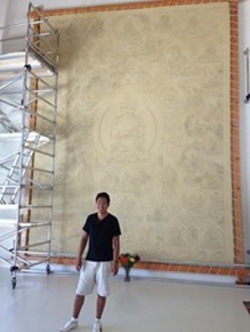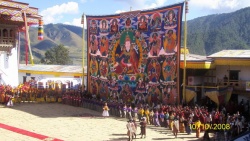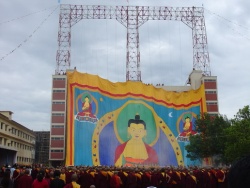Tibetan Artist’s Giant Thangka is Expression of Enormous Commitment to Tradition
Giant thangkas are usually stitched from silk and brocade, but Tashi Dhargyal is painting an enormous image of the Buddha as a way to educate the public about the precious quality of authentic Tibetan art. Fabric thangka artist Leslie Rinchen-Wongmo tells of her visit to the Tibetan painter’s giant thangka project in Sebastopol, California. Sebastopol, CA (PRWEB) September 16, 2013
Silk thangka artist Leslie Rinchen-Wongmo paid a visit last week to Tashi Dhargyal’s Tibetan Gallery & Studio in Sebastopol, California.
There, in a warehouse-like space at The Barlow, Tashi Dhargyal is painting an enormous thangka he refers to as “thangbochi” or Big Thangka. The stretched canvas is 20 feet high and 15 feet wide, filling the two-story interior of the gallery.
Thangkas this large are normally produced using the Tibetan applique techniques which Rinchen-Wongmo mastered in India under the tutelage of Tibetan master artists T.G. Dorjee Wangdu and Tenzin Gyaltsen. Wall paintings of sacred images this size are also found in some temples. But the extraordinary painting Tashi Dhargyal has just begun is the largest thangka painting on canvas ever to be produced outside Tibet -- and perhaps inside as well.
Leslie Rinchen-Wongmo was curious about this project because of its connection with the tradition of liberation through seeing -- powerfully embodied in the giant appliquè thangkas of Tibet and also in her own smaller textile artwork and the work of countless thangka painters throughout history, inside and outside of Tibet.
In addition, this visit gave Leslie the chance to reunite with her old friend Migmar Tsering, one of the finest contemporary masters of Tibetan thangka painting and Leslie’s first Tibetan language teacher. In 1992, when Leslie first arrived in Dharamsala, she and Migmar traded English and Tibetan language lessons. And Migmar introduced Leslie to her first Tibetan appliquè teacher, Tenzin Gyaltsen, probably the most exacting master of silk thangka art in the world. This summer, Tashi brought Migmar to Sebastopol to assist in the first stages of the thangbochi.
The idea for this giant thangka project grew out of Tashi’s commitment to the preservation of authentic Tibetan painting techniques.
He is deeply disturbed by the proliferation of low-quality, inaccurate thangkas, particularly from Nepal. Without proper education, travelers and collectors naively believe that these shoddily produced images are examples fine Tibetan art.
Tashi Dhargyal has dedicated his life to preserving the Tibetan thangka painting tradition and educating the public as to its finer points -- proper proportion, genuine stone pigments, well-prepared canvases, thinly applied paints, 24 karat gold, respect for one’s teachers, and a consistent adherence to excellence and tradition.
Tashi helped to found and fund the Institute of Tibetan Thangka Art in Dharamsala, India -- a school where Migmar continues to teach in the tradition of their late teacher, Sangye Yeshi. In Sebastopol, Tashi has begun teaching as well, every Sunday afternoon in the gallery.
Over the past three months, Migmar and Tashi prepared the enormous canvas --overcoming an array of technical challenges. A custom pulley system was created to lift and turn the large stretcher frame, and a special platform was created to allow the artists to climb onto the surface of the canvas in order to polish it without stretching or distorting the fabric. In the last days before Migmar returned to Dharamsala, the two artists mixed the mineral paints with which Tashi will begin his 5-year painting process.
Migmar said, “I’ve never seen or heard of a thangka painting this large anywhere. Most thangkas this size are stitched.”
Visitors to The Barlow can find Tashi painting there most days from noon to 7. The studio welcomes requests from schools, sangha, and community for special presentations or events.
About Leslie Rinchen-Wongmo:
Leslie Rinchen-Wongmo is the only westerner traditionally trained in the Tibetan art of silk appliqué thangkas. She makes sacred transformative textile art for discerning designers and homeowners who appreciate fine craft and want their spaces to reflect their commitment to spiritual and personal growth.
Through the Stitching Buddhas Virtual Apprentice Program, Rinchen-Wongmo teaches silk thangka making internationally -- giving creative, spiritually-oriented women a way to integrate their spiritual and creative paths.
His Holiness the Dalai Lama gave his blessings to Rinchen-Wongmo’s work and encouraged her to use her sacred art skills to inspire people across religions and cultures.
Contact Information:
Leslie Rinchen-Wongmo, Artist & Teacher at Threads of Awakening, Buddhist Textile Art for Sacred Spaces 805-626-8272


